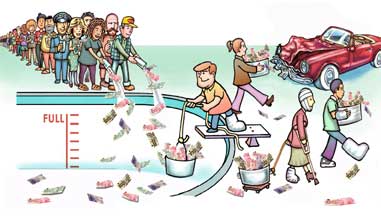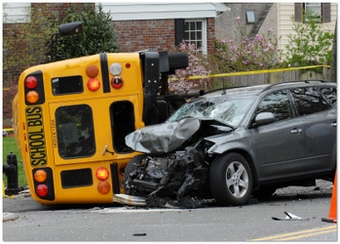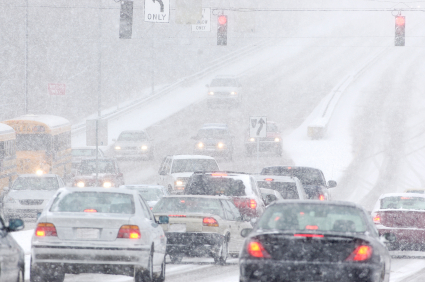
by Colin Moor, CAIB | Jul 12, 2011 | Research Centre
While it may seem complex, insurance is really quite simple: The payments (or premiums) of the many pay for the losses of a few.
Your premiums go into a large pool, if you will, at your insurance company. The claims of the few are paid from that pool. Because there are more people contributing to the pool than there are making claims, there is always enough to pay the claims – even large single claims like when someone is permanently disabled as a result of a car collision, or many smaller claims like those resulting from a natural disaster. (The 1998 ice storm that hit parts of Ontario, Quebec and New Brunswick resulted in an estimated 700,000 claims for damage totalling $1.4 billion.) However, large disasters (such as the ice storm) do come close to emptying the pool.

Insurance for insurance companies
Even when the pool comes close to emptying, there is another pool from which insurance companies can draw to pay claims. Some of your premiums are used by your insurance company to buy reinsurance – insurance for insurance companies.
Sometimes losses are so big – like those resulting from an earthquake – that there is no way that an insurance company can cover the costs. Reinsurance is an extra layer of protection against large losses.
Annual replenishing
Your insurance is an annual contract, so the pool operates for only one year at a time.
Your premiums and the premiums of others are based on how much money the insurance companies think they will need to pay the coming year’s claims. Your premiums do not build up over the years – unlike the premiums for some types of life insurance.
How premiums are calculated
Within reasonable limits, some of which are prescribed by law, your premium is calculated to reflect the probability that you will make a claim – that is, that you will draw funds from the insurance pool. Those who are unlikely to draw from the pool pay less than those who are more likely to draw from it.
Insurers take many factors into consideration to determine the likelihood that you will make a claim. A common misconception is that a policyholder who has never made a claim should pay less, little or nothing for insurance. While it is true that past claims history is important, a more reliable indicator of how likely a person or business is to make a claim is the statistical group to which he/she/it belongs.
Industry earnings
Insurance companies generally do not make money on the premiums gathered from policyholders.
In 2005, insurance companies paid more than $21 billion in claims while taking in $35 billion in premiums. The difference between the premiums and claims, in this case $14 billion, is used by the companies to pay salaries and taxes ($6.2 billion in 2005), and to cover the overhead costs (such as electricity bills) of running a business. It is also used to pay the administrative costs of settling a claim.
Insurance pays for …
Insurance pays for only those types of losses described in your contract. It is very important that you read your policy and/or talk to your insurance broker about what you are covered for and what you’re not.
Insurance will not pay for every problem that you may encounter, nor is it a maintenance contract.
Insurance is generally intended – and priced accordingly – to help policyholders cope with the financial consequences of unpredictable events that are “sudden and accidental.”
If, for example, you live on a floodplain by a river, flooding of your property in the spring is not sudden or accidental; it is inevitable and, therefore, uninsurable.
Source: Insurance Bureau of Canada

by Eddie Rodriguez, CAIB | Jul 11, 2011 | Research Centre
There are some additional coverages you can buy.
You can buy rental reimbursement (“Loss of Use“), which will pay for a rental car while your vehicle is being repaired. ( If the accident was not your fault, the cost of the rental car is automatically picked up by your insurance company .. subject to some exceptions).
If the accident is completely – or partially – your fault, you’d be covered for the Car rental cost IF you’ve bought the optional “Loss of Use” coverage.
If you’re not sure whether you’ve purchased this coverage, let us know and we’ll check your policy for you ]
If you are buying or leasing a NEW vehicle (a private passenger automibilie or a snowmobile), you can buy the “Removing Depreciation Deduction” endorsement: Under certain conditions, this endorsement waves depreciation when setting physical damage loss to new vehicles for set period of time following purchase. If your car is written off during this period you would be reimbursed the original purchase price (instead of the probably-much-lower current value).
Another very popular optional coverage (which you can buy IF you qualify) is the A.P.E …
… no, not that APE in the picture!
I’m talking about the A.P.E: Accident Protection Endorsement. This relatively-inexpensive coverage would protect you from having to pay a higher premium after your first AT-FAULT accident.
What if you damage a vehicle you don’t own … such as a rented car?!!!
Yup, you can get coverage for that (assuming you qualify). In Ontario this is known as the OPCF27. By adding an “OPCF 27” to your automobile policy, you won’t have to worry about buying extra insurance whenever you rent a car ……… Unless in cases when it would make sense to buy the insurance from the rental company. Feel free to ask an MIB broker about this to make sure you don’t waste your money.

by Eddie Rodriguez, CAIB | Jul 11, 2011 | Research Centre
Auto insurance is a product with a few distinct coverages.
Let’s look at them briefly here:
1. Bodily Injury Liability (Mandatory)- This pays the medical and other expenses of those people injured or even killed in accidents you cause. In Ontario, you are required to have a minimum coverage of $200,000.
2. Property Damage Liability (Mandatory)- This covers the damage your car causes to property such as garages, buildings, lampposts, fences, whatever. This is also mandatory in Ontario, with a minimum required coverage of $200,000.
3. “Accident Benefits” (Medical Payments, etc.) (Mandatory) – This pays medical, and even funeral, expenses for you as well as members of your family and passengers in your car if it is involved in a collision, regardless of who caused the accident. It also covers you as a pedestrian if a vehicle hits you.

*TIP: This very complex section of the Ontario Automobile Policy changed as of September 2011 – Ask your MIB broker about the differences, and find out if you need to increase your coverages to the “old standards”.
4. Direct Compensation – Property Damage (Mandatory) – Under certain conditions, covers you in Ontario for damage to your automobile and to property it is carrying when another motorist is responsible.
* Why is it called “Direct Compensation”? Because you’re directly compensated by your own insurance company – even though another party is fully or partially responsible – This saves you the expense and trouble of having to sue the other party and wait a long time to get your car fixed.
5. Uninsured Automobile (Mandatory) – This coverage protects you if you are injured or killed by an UNinsured motorist or by a hit-and-run driver. It also covers damage to your automobile caused by an identified uninsured motorist . (By the way, that’s an over-simplified summary of a very complex part of the Ontario Auto Policy).
* Fines for vehicle owners, lessees and drivers who do not carry valid automobile insurance can range from $5,000 to $50,000 …. And still, there are lots of people out there driving WITHOUT insurance. One report estimates that 1 in every 20 Ontario drivers is driving WITHOUT insurance.
6. Comprehensive – This OPTIONAL but highly recommended coverage includes protection against certain “specified perils” (^ ^see below.) as well as other insured damage to your car resulting from something other than a collision with another vehicle (See “Collision” below). For example, the Comprehensive coverage will pay for damage caused by vandals or a wind-blown tree hitting your car.
^ ^ In regards to Specified Perils the Ontario Automobile Policy says: “we will only pay for losses caused by fire; theft or attempted theft; lightning, windstorm, hail, or rising water; earthquake; explosion; riot or civil disturbance; falling or forced landing of aircraft or parts of aircraft; or the stranding, sinking, burning, derailment or collision of any kind of transport in, or upon which a described automobile is being carried on land or water”.
7. Collision – This OPTIONAL but highly recommended coverage is for damage done to your car when it collides with other vehicles (your fault) or other objects (again, your fault).
It also covers damage to your vehicle caused by an unidentified vehicle or object. For example: you park in the parking lot of the convenience store and go in to buy something …. When you come out of the store, you notice that your car has been hit and damage by another car … but the other driver took off and no one saw him or her. In this case, your policy would cover damage to your car IF you have this OPTIONAL coverage.
In Ontario, instead of buying the Collision and Comprehensive coverages separately, you can get the “All Perils” option.
What is it?
All Perils (OPTIONAL) -this option combines the coverages of Collision or Upset and Comprehensive.
In addition, this coverage (All Perils) includes loss or damage caused if a person who lives in your household steals a described automobile. Coverage also applies if an employee who drives or uses, services or repairs a described automobile, steals it.
In Ontario we also pay for an important type of protection called “Family Protection Coverage” (OPCF 44R) – Some find the name (Family Protection Coverage) misleading or confusing. Let’s clarify briefly what this coverage does for you:
You see, many of those who do have insurance don’t have enough to cover the damages and injuries that would result in a major collision.
What if YOU getting into accident with someone who doesn’t have ENOUGH insurance for the damages they cause to you?
If you don’t have this coverage, which is often referred to as Under-Insured motorist, you are taking a risk.
If you do have this coverage, your insurance company will pay (or as they say: “indemnify an eligible claimant”) for the amount that you are legally entitled to recover from an inadequately insured motorist as compensatory damages in respect of bodily injury to or death of an insured person arising directly or indirectly from the use or operation of an automobile.

by Eddie Rodriguez, CAIB | Jul 11, 2011 | Research Centre
In Ontario, auto insurance is mandatory. But the government doesn’t require you to buy ‘Accident Benefit upgrades ‘ or the so-called ‘full coverage’. You are only required to buy the minimum liability coverage*. This is so you can pay for some of the damage your car does to other people or other people’s property..
* In this other article, I’ll point out OTHER ‘insurance coverages‘ that are also mandatory in Ontario.
How much are you required to buy? In Ontario, the minimum liability amount is $200,000. That’s not much. In fact, it’s next to nothing.

* Tip. The minimum amount of insurance required in Ontario is NOT much. Seriously consider getting more coverage ($2,000,000.00 or more) in order to protect your financial health.
* Note. Notice that mandatory auto insurance laws in Ontario do not require you to buy certain coverages for your own car. It’s up to you to decide if you want to buy protection against such risks as vandalism, fire, theft and damage to your car in case of an “at-fault” collision.
If you buy just the minimum coverage required by law, you are leaving your assets at considerable risk. Your car, obviously. And your home, if you are at fault in an accident that causes serious injuries to the other parties.
How far do you think the minimum $200,000 will go if you hurt somebody and they can’t work for 5 years?
Not far enough!

by Eddie Rodriguez, CAIB | Jul 11, 2011 | Research Centre
There are several ways you can purchase auto insurance. You can buy it over the Internet at literally hundreds of different web sites. You can call an 800 number and buy it over the phone directly from an auto insurance company. You can call an insurance agent or an insurance broker. In some cases, you can buy from a bank or credit union.
It’s not surprising you can buy it in so many ways. After all, there are hundreds of insurance companies that sell auto coverage in your area.

How do these companies differentiate themselves? Some brag about their superior service when you have a claim. Some tout how easy it is to buy from them. And, often, auto insurance companies try to compete on price, just as if you were buying a plane ticket, a CD or a pop.
* Tip. Some people believe auto insurance is just a commodity. It’s not.
You’re not buying a soft drink. You’re protecting your financial well being … and the choices you make could affect you for the rest of your life.
If you think auto insurance is a commodity, consider this:
A person with a good driving record will pay three, five, even 10 times less than a driver with a couple of tickets, an accident or who has been cited for and convicted of driving under the influence.
A person who lives in a major city – say Toronto or Brampton- will pay three, four, even five times more than someone who lives in a rural area or small town, even though the two have the same driving records.
–






